Completed pavise pics pg 3/ Wattle & plank mantlet pics
Moderator: Glen K
-
Fire Stryker
- Archive Member
- Posts: 851
- Joined: Tue Sep 26, 2000 1:01 am
- Location: South Carolinian living abroad in NH
- Contact:
-
chef de chambre
- Archive Member
- Posts: 28806
- Joined: Thu Aug 10, 2000 1:01 am
- Location: Nashua, N.H. U.S.
- Contact:
Hi Lorenzo,lorenzo2 wrote:Nice take on the javalins / hand darts. I have seen pics in manuscripts before but was never sure how seriously to take them. Recreating them was a neat idea. Will you be doing some target practice? I am interested in learning how well they work after you have had a chance to use them a bit.
They definitely existed, and at least in mid 15th century Burgundy, they had large numbers of components for making them in store, as well as numbers of different types made up. They were a part of the armament for a ship, in addition to being stored in castle armouries for use in siege.
The ones we have are most effective thrown down from the height of 15 ' or more, and while they may have additionally been used in hunting, and were definitely for sport, I doubt the type we have made were used in warfare outside of siege work or in naval use.
Larger, and probably more effective examples were used by light horse in Spain, and Stradiot in Italy. I will be making up a pair of that sort later this Summer.
-
chef de chambre
- Archive Member
- Posts: 28806
- Joined: Thu Aug 10, 2000 1:01 am
- Location: Nashua, N.H. U.S.
- Contact:
More images.
We have finally gotten around to weaving in the cross member of the wooden prop for the wattle mantlet.
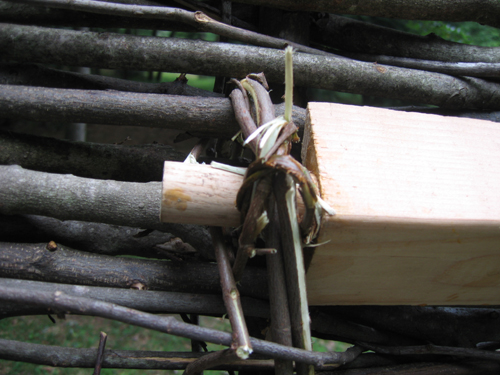
We had been stumped as to how to go about this, but Mac provided the sugestion of getting some thin green sapling branches, and then braiding/plaiting them for strength and flexibility, to enable them to be woven into a bracket.
The idea worked very well, but in weaving the support in place, the actual braiding came loose, as you can see.
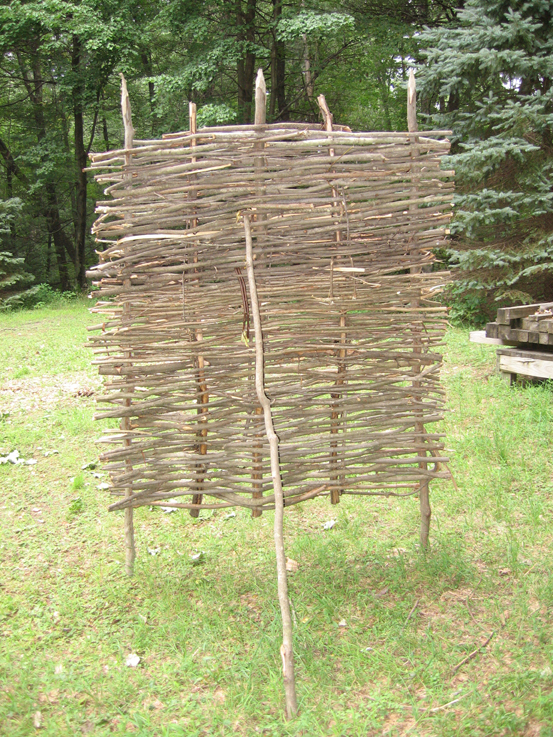
Here it is, propped up from the front-side, now that we have established the height, I can cut the permanent wood prop, and affix it to the cossed support we just wove in. Over the last couple of weeks, the green wood has shrunk some, so we will weave in some more filler, to stop up the gaps you can see now. We still need to trim the bottom two legs, and 'sharpen' them.
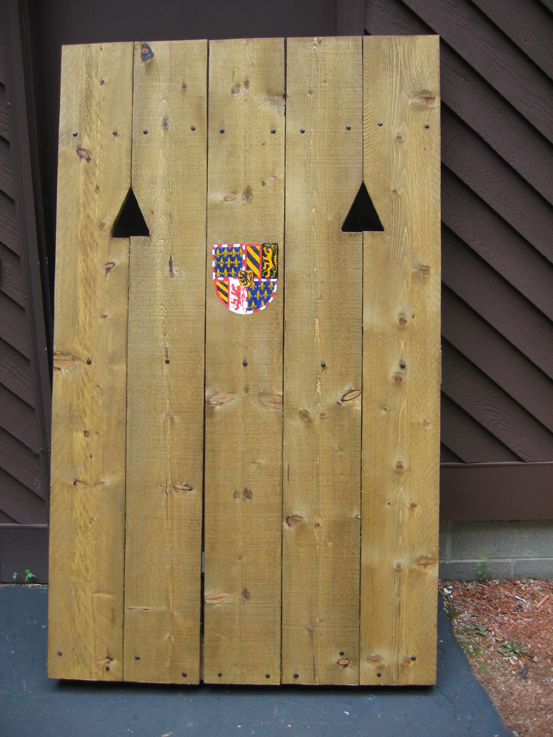
THe Burgundian arms on the plank mantlet has progressed as well, we have touched up the lion of Flanders. We had to go back in on the central lion of Hainault/holland, and widen the yellow, as when we did the initial outline of the escutcheon in black, the paint ran, Next week, I trim up the escutcheon once again, and it will lodse the 'lop-sided' look.
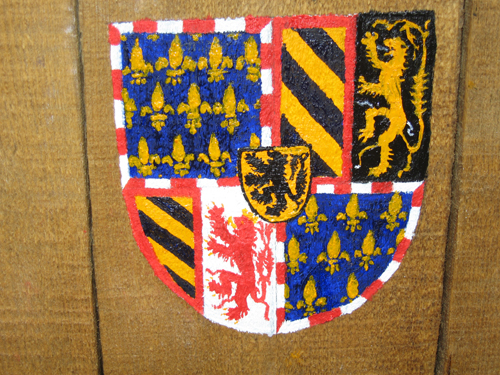
Next week, the lion of Flanders gets the last of it's fur, and is armed and launged, the center escutcheon is touched up, the lion of Luxembourg gets its detailing, and the Fleur de lys gets sharpened and adjusted. We have probably 2 more weeks work, before we varnish the coat of arms. We had the ironwork for the pin for the support made last weekend, so this is getting close to being done as a entire mantlet.
I still have to bind the javelin fletching, but I don't need it for a presentation until the Saturday next, so it is temporatily on the back-burner.
We have finally gotten around to weaving in the cross member of the wooden prop for the wattle mantlet.

We had been stumped as to how to go about this, but Mac provided the sugestion of getting some thin green sapling branches, and then braiding/plaiting them for strength and flexibility, to enable them to be woven into a bracket.
The idea worked very well, but in weaving the support in place, the actual braiding came loose, as you can see.

Here it is, propped up from the front-side, now that we have established the height, I can cut the permanent wood prop, and affix it to the cossed support we just wove in. Over the last couple of weeks, the green wood has shrunk some, so we will weave in some more filler, to stop up the gaps you can see now. We still need to trim the bottom two legs, and 'sharpen' them.

THe Burgundian arms on the plank mantlet has progressed as well, we have touched up the lion of Flanders. We had to go back in on the central lion of Hainault/holland, and widen the yellow, as when we did the initial outline of the escutcheon in black, the paint ran, Next week, I trim up the escutcheon once again, and it will lodse the 'lop-sided' look.

Next week, the lion of Flanders gets the last of it's fur, and is armed and launged, the center escutcheon is touched up, the lion of Luxembourg gets its detailing, and the Fleur de lys gets sharpened and adjusted. We have probably 2 more weeks work, before we varnish the coat of arms. We had the ironwork for the pin for the support made last weekend, so this is getting close to being done as a entire mantlet.
I still have to bind the javelin fletching, but I don't need it for a presentation until the Saturday next, so it is temporatily on the back-burner.
those hand darts are awesome! I am so going to try and make something like that for use with my sca kit.... throw it then draw my sword... so cool.
Thanks for the inspiration Chef
Thanks for the inspiration Chef
Lord Alexander Clarke, Righteous Brother of the Priory of St. Colin the Dude, The Bear of Hadchester, Squire to Sir Cedric of Thanet
~Chivalry unpaired with Valor is a meal to starve a mans soul~
~Chivalry unpaired with Valor is a meal to starve a mans soul~
-
chef de chambre
- Archive Member
- Posts: 28806
- Joined: Thu Aug 10, 2000 1:01 am
- Location: Nashua, N.H. U.S.
- Contact:
Hi MJ,MJBlazek wrote:those hand darts are awesome! I am so going to try and make something like that for use with my sca kit.... throw it then draw my sword... so cool.
Thanks for the inspiration Chef
Glad they inspired. Making them work for you will be a matter of getting them balanced, and figuring out how to do that, and deliver a punch, I think.
-
chef de chambre
- Archive Member
- Posts: 28806
- Joined: Thu Aug 10, 2000 1:01 am
- Location: Nashua, N.H. U.S.
- Contact:
Here are some images of the wattle mantlet finished.
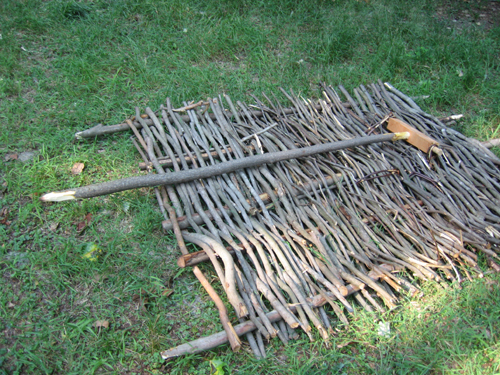
Here it is playing down collapsed, you can see we shortened the legs, and sharpened them up, and the prop in its socket in the cross-timber prop
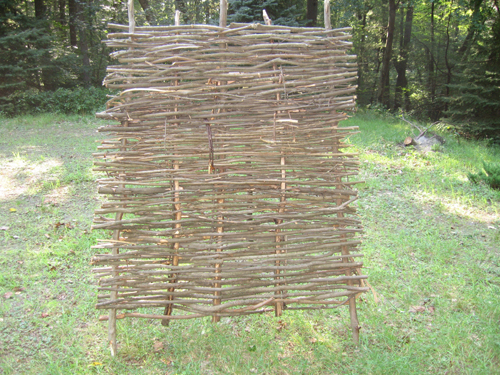
Completed front
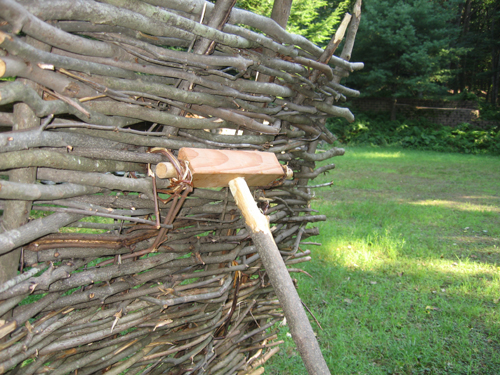
Showing a close up of the prop, and how it is set into the mantlet.
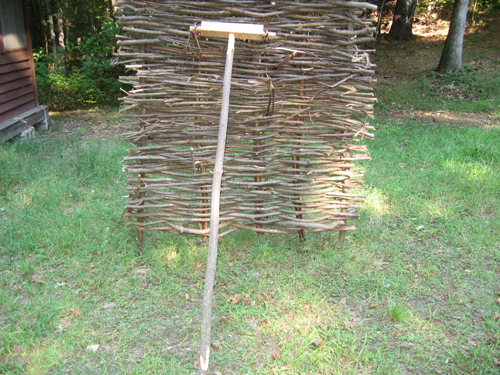
Full on from the rear.
The thing is incredibly strong, having beaten on it with a heavy billhook, cutting, trimming,. and trying to keep it pounded together, I think you would literally have to take it apart with an axe, and take out a section at a time to break it up.

Here it is playing down collapsed, you can see we shortened the legs, and sharpened them up, and the prop in its socket in the cross-timber prop

Completed front

Showing a close up of the prop, and how it is set into the mantlet.

Full on from the rear.
The thing is incredibly strong, having beaten on it with a heavy billhook, cutting, trimming,. and trying to keep it pounded together, I think you would literally have to take it apart with an axe, and take out a section at a time to break it up.
-
chef de chambre
- Archive Member
- Posts: 28806
- Joined: Thu Aug 10, 2000 1:01 am
- Location: Nashua, N.H. U.S.
- Contact:
Pavise project
Here is a pavise we are working on (one of a set of 3), copied in shape and size from the two surviving small pavises of die Burgunderbeute (yes, it is flat-ish, as was the original)
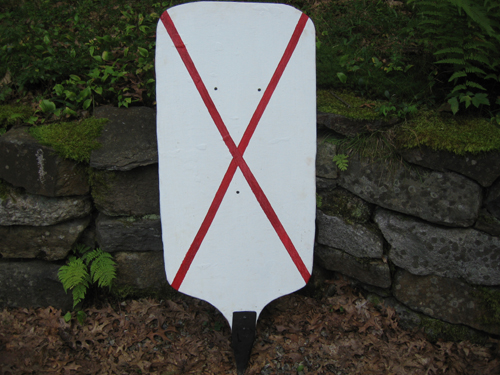
Clay Gilbert of Fungi Forge made the pavise spike, and the handle.
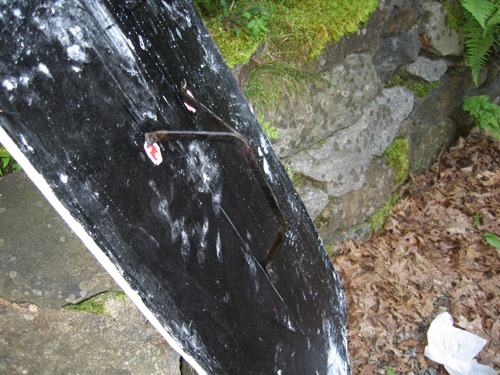
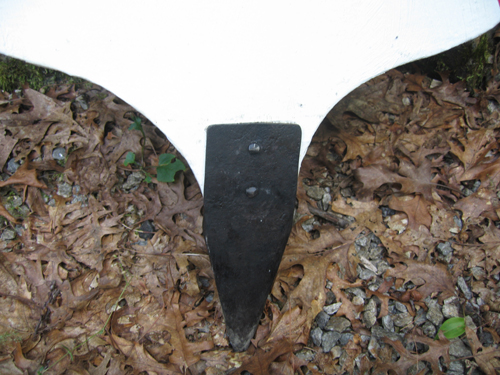
THe painting is hardly underway, we have only painted the field, and to indicate the St. Andrews cross., which will be slightly widened. There will be 4 firestrikers in goold, 4 black flints, and the entire field powdered with red flames, on the two white pavises. We also have one underway with the same design, but with a split field in Burgundian livery (parti-per pale, argent and azure).
These are 'beater' pavise, in that they have a plywood core, and are covered with fabric and gessoed, instead of being covered with deerskin, like the original. We have one that has been underway for a while, that will be covered in deerskin, like the original, made of poplar boards, like the original. The three beater pavise for the field are the test run for the reconstruction. I don't mind using these ones, but I would cry if we wrecked the reconstruction.
There are three extant pavises like this, two from 1476, one of which is blue and white, the other being white overall. One exists from 1480, to the exact same pattern, made for Maximilian I, during his wars of Burgundian succession.

Clay Gilbert of Fungi Forge made the pavise spike, and the handle.


THe painting is hardly underway, we have only painted the field, and to indicate the St. Andrews cross., which will be slightly widened. There will be 4 firestrikers in goold, 4 black flints, and the entire field powdered with red flames, on the two white pavises. We also have one underway with the same design, but with a split field in Burgundian livery (parti-per pale, argent and azure).
These are 'beater' pavise, in that they have a plywood core, and are covered with fabric and gessoed, instead of being covered with deerskin, like the original. We have one that has been underway for a while, that will be covered in deerskin, like the original, made of poplar boards, like the original. The three beater pavise for the field are the test run for the reconstruction. I don't mind using these ones, but I would cry if we wrecked the reconstruction.
There are three extant pavises like this, two from 1476, one of which is blue and white, the other being white overall. One exists from 1480, to the exact same pattern, made for Maximilian I, during his wars of Burgundian succession.
- earnest carruthers
- Archive Member
- Posts: 1801
- Joined: Tue Jan 04, 2005 2:39 pm
- Location: East Anglia, UK
The army museum in Delft also has a 'coopered' burgundian, similar in style, the board is made of uprights over an inch across, cut slightly at an agnle then glued or otherwise joined to form a curve. Gesso, horsehair and either cloth or hide covered can't remember, painted of course, with ground spike. Not huge either.
"but I would cry if we wrecked the reconstruction."
Mate, it would take a lot to wreck a well made reconstruction . I made a 'germanic' type one years back, inch or thereabouts thick lime wood, canvas, gesso etc, it has been shot with handguns, high powered bow and hacked, mainly superficial damage, except for the ball, went through it, arrow was stopped an inch or so, hacks take a lot to get through.
. I made a 'germanic' type one years back, inch or thereabouts thick lime wood, canvas, gesso etc, it has been shot with handguns, high powered bow and hacked, mainly superficial damage, except for the ball, went through it, arrow was stopped an inch or so, hacks take a lot to get through.
Yours will be fine, the only thing that would need sorting would be the paint work and the skin, even then the skin should not run when cut.
"but I would cry if we wrecked the reconstruction."
Mate, it would take a lot to wreck a well made reconstruction
Yours will be fine, the only thing that would need sorting would be the paint work and the skin, even then the skin should not run when cut.
Devoted admirer and yay sayer of
http://www.larsdatter.com/
Karen 'she-who-rocketh-verily' Larsdatter
my blog
http://medievalcolours.blogspot.com
http://www.larsdatter.com/
Karen 'she-who-rocketh-verily' Larsdatter
my blog
http://medievalcolours.blogspot.com
-
fungi forge
- Archive Member
- Posts: 427
- Joined: Fri Apr 03, 2009 1:59 pm
- Location: Missouri
- Contact:
-
chef de chambre
- Archive Member
- Posts: 28806
- Joined: Thu Aug 10, 2000 1:01 am
- Location: Nashua, N.H. U.S.
- Contact:
OK, to correct myself, I would cry if I smudged, or otherwise de-prettified the reconstruction.earnest carruthers wrote:The army museum in Delft also has a 'coopered' burgundian, similar in style, the board is made of uprights over an inch across, cut slightly at an agnle then glued or otherwise joined to form a curve. Gesso, horsehair and either cloth or hide covered can't remember, painted of course, with ground spike. Not huge either.
"but I would cry if we wrecked the reconstruction."
Mate, it would take a lot to wreck a well made reconstruction. I made a 'germanic' type one years back, inch or thereabouts thick lime wood, canvas, gesso etc, it has been shot with handguns, high powered bow and hacked, mainly superficial damage, except for the ball, went through it, arrow was stopped an inch or so, hacks take a lot to get through.
Yours will be fine, the only thing that would need sorting would be the paint work and the skin, even then the skin should not run when cut.
I'll bring that out for show and tell, but I'll probably end up hanging it on the wall, as if it were a Van der Weyden panel.
The mantlets and such, will be shot at, hacked, and otherwise properly used.
-
chef de chambre
- Archive Member
- Posts: 28806
- Joined: Thu Aug 10, 2000 1:01 am
- Location: Nashua, N.H. U.S.
- Contact:
Hi Steven,Steven H wrote:This is all very impressive. Thanks for sharing.
Cheers,
Steven
P.S. I live in Boston, so . . . when's the next event where I can see these in person
Well, we do a presentation at the Higgins museum the first saturday of every month, but the mantlets won't make it out there, until we do a specific artillery show, which will probably be this coming Spring,
In the Summer, we have a monthly 'drill and grill', where we have this stuff set up, we do archery, drill with halberds and glaives, horses, etc.
Recently we haven't had any field events outside of the New Hampshire Renaissance fair, due to third party insurance coverage issues. The arquebuses, and small artillery will be making it up to a private range in Main this Fall, to do some test shooting (live fire), for photos and data for a book.
-
chef de chambre
- Archive Member
- Posts: 28806
- Joined: Thu Aug 10, 2000 1:01 am
- Location: Nashua, N.H. U.S.
- Contact:
PLank Mantlet, with trail being completed
Here is a few images opf the plank mantlet project working its way to completion, with the addition of the trail
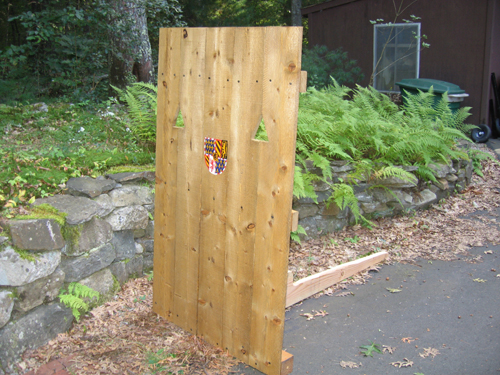
The project had ground to a halt, while one of our members was waiting to make ironwork for it on our Civil War batteries forge (we have some cross-membership with the 5th Mass battery, which has a fully functional field forge and limber) Couldn't plan out the details of the trail without the through pin for it, and not wanting to screw it up, we left it lay for a bit, just working on the coat of arms.
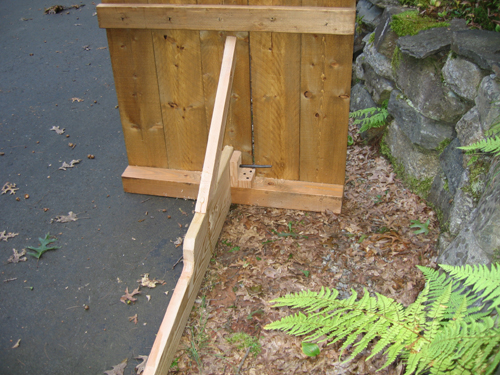
Because the mantlet is wheeled, and can be moved forward by a single man, picking up the trail and [pushing, the trail needed a strut branching off of it, to contact the screen at near the midpoint, otherwise the stress on the trail would work to destroy the small block it passes through at the point of the through-pins passage.
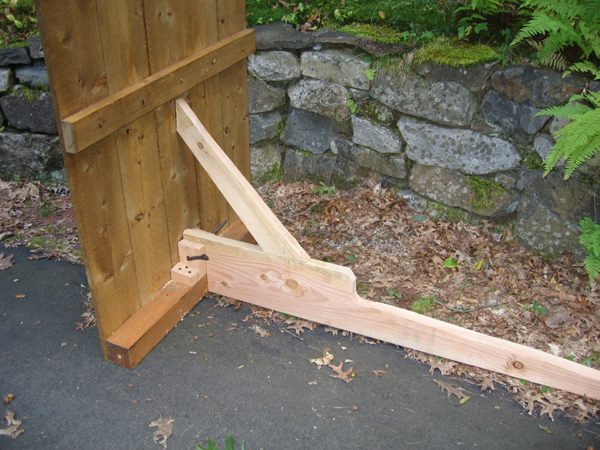
The strut is joined to the trail by pegging with long dowels - a monumental pain in the posterior to do with the small range of tools I presently own - I haven't had access to a real woodshop since 1998.
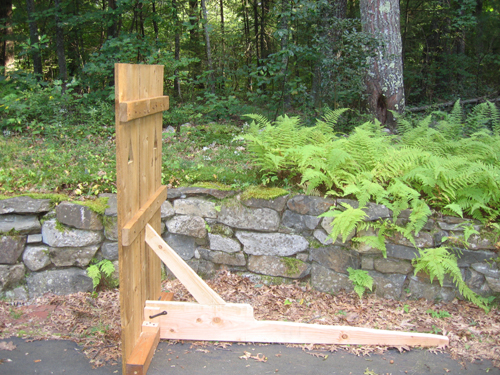
There are a pair of 10" oak wheels (solid) that will peg onto axles made of oak doweling, that are the last phase of the project, along with putting an oak dowel through the trail near the tail of it, to ease and speed lifting and movering - not that an oak axel and wheel arrangement is going to allow the winning of any races, except maybe seeing how fast it drips grease that it will need for lubricant. But the thing will be moble, which was the intent, so we could move the screen forward so the guners will be covered while reloading the crapadeau.

The project had ground to a halt, while one of our members was waiting to make ironwork for it on our Civil War batteries forge (we have some cross-membership with the 5th Mass battery, which has a fully functional field forge and limber) Couldn't plan out the details of the trail without the through pin for it, and not wanting to screw it up, we left it lay for a bit, just working on the coat of arms.

Because the mantlet is wheeled, and can be moved forward by a single man, picking up the trail and [pushing, the trail needed a strut branching off of it, to contact the screen at near the midpoint, otherwise the stress on the trail would work to destroy the small block it passes through at the point of the through-pins passage.

The strut is joined to the trail by pegging with long dowels - a monumental pain in the posterior to do with the small range of tools I presently own - I haven't had access to a real woodshop since 1998.

There are a pair of 10" oak wheels (solid) that will peg onto axles made of oak doweling, that are the last phase of the project, along with putting an oak dowel through the trail near the tail of it, to ease and speed lifting and movering - not that an oak axel and wheel arrangement is going to allow the winning of any races, except maybe seeing how fast it drips grease that it will need for lubricant. But the thing will be moble, which was the intent, so we could move the screen forward so the guners will be covered while reloading the crapadeau.
- Otto von Teich
- Archive Member
- Posts: 17440
- Joined: Thu Nov 09, 2000 2:01 am
- Location: The Great State of Texas.
-
chef de chambre
- Archive Member
- Posts: 28806
- Joined: Thu Aug 10, 2000 1:01 am
- Location: Nashua, N.H. U.S.
- Contact:
-
chef de chambre
- Archive Member
- Posts: 28806
- Joined: Thu Aug 10, 2000 1:01 am
- Location: Nashua, N.H. U.S.
- Contact:
Pavise nearly completed
Here is a couple of images of the pavises we had underway, almost complete.
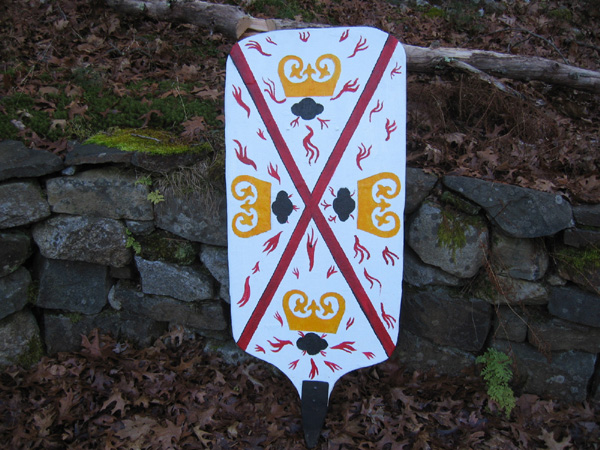
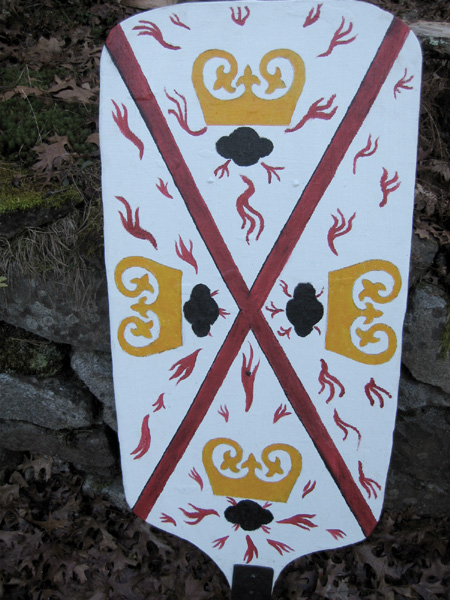
Since this photo, I've put the brown/black detailing lines on the firestrikers. I'll try to get an image when it drys a bit, and the snowing stops.
These are props, rather than being reconstructions, and are for use in the field and at the Higgins. Plywood, cloth, gesso, and modern oilpaints. They are the correct size, they are flat , one extant example at grandson is, and the one from 1483 to the same pattern Peter FIner sold a few years back is pretty flat as well, the rest have a slight curve to them, very slight. The really curved one is at the Dutch army museum in Delft showed up at a Hermans Historica auction from a proivae Eastern European collection almost 10 years back, and as it is unique in shape and form, I have my doubts about it being genuine, thinking it a possible forgery. The examples in Switzerland are genuine with a good pedigree.
The real ones are out of three planks of linden or tuilip, and are covered in deerskin We have an on-again off again project for a reconstruction, which sits idle because none of us in the group are sure how to handle the deerkin covering.
Clay at Fungi Forge made the ironwork for these - the spike is wider than the original, due to a concern with using them on stage at the Higgins auditorium, not wanting to damage the stage.


Since this photo, I've put the brown/black detailing lines on the firestrikers. I'll try to get an image when it drys a bit, and the snowing stops.
These are props, rather than being reconstructions, and are for use in the field and at the Higgins. Plywood, cloth, gesso, and modern oilpaints. They are the correct size, they are flat , one extant example at grandson is, and the one from 1483 to the same pattern Peter FIner sold a few years back is pretty flat as well, the rest have a slight curve to them, very slight. The really curved one is at the Dutch army museum in Delft showed up at a Hermans Historica auction from a proivae Eastern European collection almost 10 years back, and as it is unique in shape and form, I have my doubts about it being genuine, thinking it a possible forgery. The examples in Switzerland are genuine with a good pedigree.
The real ones are out of three planks of linden or tuilip, and are covered in deerskin We have an on-again off again project for a reconstruction, which sits idle because none of us in the group are sure how to handle the deerkin covering.
Clay at Fungi Forge made the ironwork for these - the spike is wider than the original, due to a concern with using them on stage at the Higgins auditorium, not wanting to damage the stage.
- Donal Mac Ruiseart
- Archive Member
- Posts: 7267
- Joined: Tue Apr 03, 2007 8:56 am
- Location: North Frontier, Barony of Marinus, Kingdom of Atlantia (Norfolk, Virginia USA)
The wattle pavise - - - what was its usage? Seems that it would protect against thrown rocks and the like, but would not be much good against arrows or anything narrow and pointed.
But that's just from observing. I've no idea how effective they'd really be.
But that's just from observing. I've no idea how effective they'd really be.
Donal Mac Ruiseart O. Pel
Squire to Viscount Tojenareum Grenville (TJ)
Be without fear in the face of thine enemies
Stand brave and upright that the Lord may love thee
Speak the truth always even if it means thy death
Protect the helpless and do no wrong
Squire to Viscount Tojenareum Grenville (TJ)
Be without fear in the face of thine enemies
Stand brave and upright that the Lord may love thee
Speak the truth always even if it means thy death
Protect the helpless and do no wrong
-
chef de chambre
- Archive Member
- Posts: 28806
- Joined: Thu Aug 10, 2000 1:01 am
- Location: Nashua, N.H. U.S.
- Contact:
-
chef de chambre
- Archive Member
- Posts: 28806
- Joined: Thu Aug 10, 2000 1:01 am
- Location: Nashua, N.H. U.S.
- Contact:
It is used as a cheaply made screen, effective against any sort of projectile short of artillery, or a handgonne bullet. It actually works very well catching arrows, abut a third bounce off outright, the remainder catch in the weave, and invariably stop by the friction of the arrows shaft against the branches, with only a few inches of penetration. We have shot scores of arrows at it, and we had exactly one penetration through and through a gap, and none else.Donal Mac Ruiseart wrote:The wattle pavise - - - what was its usage? Seems that it would protect against thrown rocks and the like, but would not be much good against arrows or anything narrow and pointed.
But that's just from observing. I've no idea how effective they'd really be.
That happened when we still had some branches left to weave, and it passed through a wider than average gap. I doubt it would again now that it is finished. You would need an axe to take that mantlet apart, as it stands right now.
-
chef de chambre
- Archive Member
- Posts: 28806
- Joined: Thu Aug 10, 2000 1:01 am
- Location: Nashua, N.H. U.S.
- Contact:
They did that, especially in the 1420's and 1440's, but you would have to make a deep slit to get it to a good position to rest a gun. That size of a pavise would be a step or two up from the pavise we made, and a step down in size from the mantlet. I think that sort of mantlet would scale out to about chin high. The mantlet we made could stand to be 6-12" taller, but they we would have problems transporting it.Maeryk wrote:Hey Chef.. the big flat mantlet.. I've seem em with gonne notches in the top off to one side.. gonna do that? Or wrong period?
You actually can use the triangular holes to a degree for shooting through. I copied the plank arrrangement out of artillery screens in the Schilling chronicle of Berne.
- brewer
- Archive Member
- Posts: 2960
- Joined: Thu Mar 20, 2003 2:01 am
- Location: Easton, PA USA
- Contact:
Bob, these things are a big bowl of Win and Cookies slathered with Awesome-sauce.
Good job!
Good job!
Reconstructing History - The finest historical clothing and patterns on the market!
kirtle - cotehardie - medieval dress pattern
"Could you please move, you're blocking my awesomeness" - Halvgrimr
kirtle - cotehardie - medieval dress pattern
"Could you please move, you're blocking my awesomeness" - Halvgrimr
- Donal Mac Ruiseart
- Archive Member
- Posts: 7267
- Joined: Tue Apr 03, 2007 8:56 am
- Location: North Frontier, Barony of Marinus, Kingdom of Atlantia (Norfolk, Virginia USA)
Hmmm, I could see someone thinking that with the first couple of pics, but the ones where you can see the vegetation through 'em?lorenzo2 wrote:How funny, I also assumed the holes were art work!
I've definitely learnt something from the description of the effectiveness of the wattle pavise. Its appearance is deceptive. Looks rickety, but I can understand how it works.
I can also see how they'd be good when you want to make a charge. Have everyone hunker down behind a row of them, and at the command, just push them forward. They land flat, and forward the pikes!
Donal Mac Ruiseart O. Pel
Squire to Viscount Tojenareum Grenville (TJ)
Be without fear in the face of thine enemies
Stand brave and upright that the Lord may love thee
Speak the truth always even if it means thy death
Protect the helpless and do no wrong
Squire to Viscount Tojenareum Grenville (TJ)
Be without fear in the face of thine enemies
Stand brave and upright that the Lord may love thee
Speak the truth always even if it means thy death
Protect the helpless and do no wrong
- sha-ul
- Archive Member
- Posts: 10636
- Joined: Sat Sep 09, 2006 4:16 pm
- Location: barony of vatavia,calontir, west of Wichita
- Contact:
sorry for the derail Chef, But can you tell me if wattle was used for fencing& corrals in period?
I have had the random thought bouncing through my head to make an enclosure around a camp to help keep the kids corralled& wondered if it would be even remotely appropriate.
I have had the random thought bouncing through my head to make an enclosure around a camp to help keep the kids corralled& wondered if it would be even remotely appropriate.
Whenever the legislators endeavor to take away and destroy the property of the people, or to reduce them to slavery under arbitrary power, they put themselves into a state of war with the people, who are thereupon absolved from any further obedience
-
chef de chambre
- Archive Member
- Posts: 28806
- Joined: Thu Aug 10, 2000 1:01 am
- Location: Nashua, N.H. U.S.
- Contact:
-
chef de chambre
- Archive Member
- Posts: 28806
- Joined: Thu Aug 10, 2000 1:01 am
- Location: Nashua, N.H. U.S.
- Contact:
Yes, it was used extensively for fencing in period, and many books of hours have a scene showing people constructing and repairing them. They would work well for your intended purpooses, as they were used to keep cattle out of crops and make paddocks and line pastures historically. Pretty much every cottar in England would have one, surrounding and protecting their garden to keep swine out, etc.sha-ul wrote:sorry for the derail Chef, But can you tell me if wattle was used for fencing& corrals in period?
I have had the random thought bouncing through my head to make an enclosure around a camp to help keep the kids corralled& wondered if it would be even remotely appropriate.
ETA, the ones used for fences did not need so many uprights so close together, which increases the difficulty of making one, and its effectiveness as an arrow catcher, but not its effectiveness as a fence.
-
Jeff J
- Archive Member
- Posts: 9181
- Joined: Tue Aug 22, 2000 1:01 am
- Location: Adrift Just Off the Islets of Langerhans: Latitude N 39° 2' 55.3, Longitude W 104° 48' 50.4
When you consider that mantlets are often a sieging tool, and in a siege situation the attackers gonnes are going to be pointed up, then high notches become practical/desireable.chef de chambre wrote:They did that, especially in the 1420's and 1440's, but you would have to make a deep slit to get it to a good position to rest a gun. That size of a pavise would be a step or two up from the pavise we made, and a step down in size from the mantlet. I think that sort of mantlet would scale out to about chin high. The mantlet we made could stand to be 6-12" taller, but they we would have problems transporting it.Maeryk wrote:Hey Chef.. the big flat mantlet.. I've seem em with gonne notches in the top off to one side.. gonna do that? Or wrong period?
Cool wattle. I've been looking for some decent willow for wattles. And for gunpowder. Seems willow charcoal makes some of the best performing powder.
BONANZA!!!
-
chef de chambre
- Archive Member
- Posts: 28806
- Joined: Thu Aug 10, 2000 1:01 am
- Location: Nashua, N.H. U.S.
- Contact:
Hi Guran,
Thanks for the kind words.
The fewer the uprights, the further apart they are spaced, the easier the weaving of the wattle is. So it is much easier to build fencing around a field, than either infill panels for half-timbering, or a mantlet.
THe fellow who spearheaded the project learned how to do the weaving by working on post and beam half timbered buildings. One of the problems we had was in the weaving, the increasing tension trying to force the uprights apart, which has made the bottom of the mantlet slightly wider than the top - it was woven upside down, so the tension problems are most noticable at the top as the uprights are woven. We alleviated the problem as best we may have by using a rope as a tensioner across the top, and constantly tightening it, but the spread still happened.
Thanks for the kind words.
The fewer the uprights, the further apart they are spaced, the easier the weaving of the wattle is. So it is much easier to build fencing around a field, than either infill panels for half-timbering, or a mantlet.
THe fellow who spearheaded the project learned how to do the weaving by working on post and beam half timbered buildings. One of the problems we had was in the weaving, the increasing tension trying to force the uprights apart, which has made the bottom of the mantlet slightly wider than the top - it was woven upside down, so the tension problems are most noticable at the top as the uprights are woven. We alleviated the problem as best we may have by using a rope as a tensioner across the top, and constantly tightening it, but the spread still happened.
